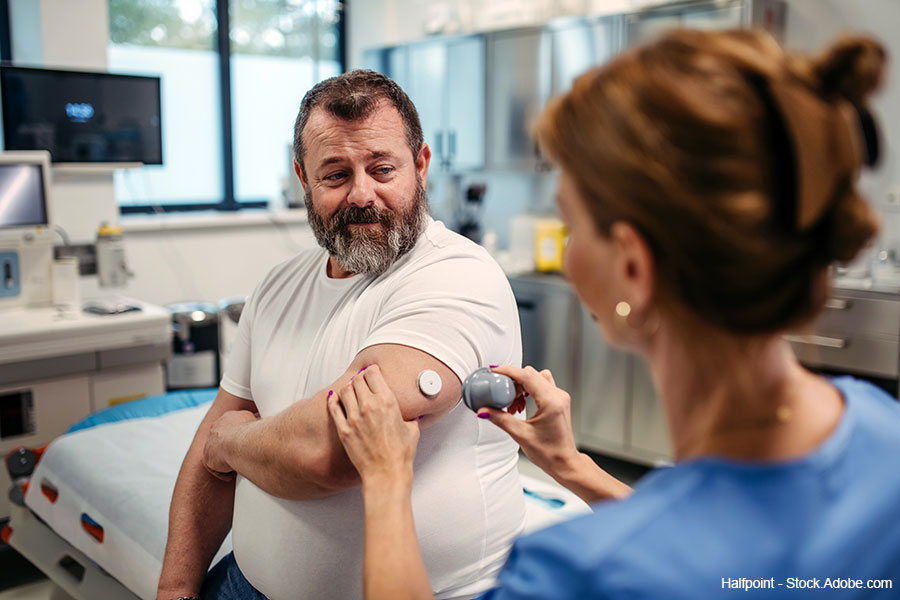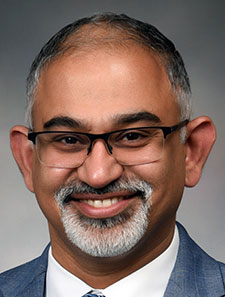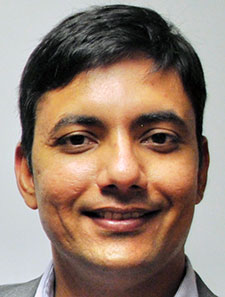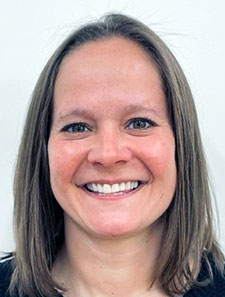 Charumathi Raghu Subramanian, MD, a hospitalist and second-year clinical informatics fellow at the University of California San Francisco School of Medicine in San Francisco, remembers a patient in her care who was wearing a continuous glucose monitor (CGM), a little disc that adheres to the arm, where a tiny, embedded filament measures, with the help of a smartphone app, interstitial blood sugar, considered a reliable proxy for blood sugar.
Charumathi Raghu Subramanian, MD, a hospitalist and second-year clinical informatics fellow at the University of California San Francisco School of Medicine in San Francisco, remembers a patient in her care who was wearing a continuous glucose monitor (CGM), a little disc that adheres to the arm, where a tiny, embedded filament measures, with the help of a smartphone app, interstitial blood sugar, considered a reliable proxy for blood sugar.

Dr. Subramanian
These CGMs are typically worn by diabetics as well as health aficionados in the course of their daily lives to help them better understand how their eating, exercise, and sleep habits affect their blood sugar. But once patients are admitted to the hospital, of course, they continue to produce data, posing a question of how they’re to be used.
Dr. Subramanian’s patient saw, via the CGM, that their blood sugar was falling, and alerted her “before they had symptoms.”
“It definitely alerted us earlier than the needle check,” she said.

Dr. Chadha
Romil Chadha, MD, MBA, MPH, FACP, SFHM, chief medical informatics officer for UK HealthCare at the University of Kentucky in Lexington, Ky., has had similar favorable experiences, but said there is another side of the coin, as well.
His division once had a patient with a CGM who followed the glucose level closely and thought the hospitalist staff was not keeping it sufficiently under control.
“‘You all,’” Dr. Chadha recalls the patient telling the hospital staff, “‘don’t know what you are doing because I can manage my blood sugars at home much better than this.’” In this case, the levels were not falling into a problematic range, and it was likely a case of shared decision making and goal setting, requiring a conversation with the patient. Dr. Chadha pointed out that the patient wasn’t at fault for paying attention to the data.
What to do with the data
As wearable devices—such as CGMs, smartwatches, and rings—become more common in helping people track every health indicator from glucose levels to oxygen levels to heart rate to steps to sleep hours, they inevitably end up not just in living rooms, bedrooms, and gyms, but also in hospital rooms. Hospitalists caring for the patients wearing them are not always certain what to do—if anything—with the data they are incessantly producing.

Dr. Patel
Typically, there is no regulation overseeing the devices, said Mihir H. Patel, MD, MPH, MBA, SFHM, a hospitalist and medical director for virtual medicine at Ballad Health in Johnson City, Tenn., where he also chairs the inpatient clinical informatics council. He is the current chair of SHM’s Health IT Special Interest Group.
“These wearable devices, like smartwatches or Fitbit health trackers, have become widespread because they are now accessible to the general population,” Dr. Patel said. “However, the critical question is whether these devices are U.S. Food and Drug Administration (FDA)-approved for inpatient use. In most cases, they are not.”
With online testimonials promoting the value of tracking glucose levels, CGMs are becoming one of the most common devices, with the most potential for having a tangible impact on patient care.
Their use has fallen into a gray area, with the FDA saying it would not object to the use of CGMs in the inpatient setting, in response to questions about whether they might be a tool to limit unnecessary interactions to prevent the spread of COVID-19. But this was short of a traditional approval for the devices in this setting.
Dr. Patel said hospitalists may use data from CGMs, but with limitations. While a patient may still require fingerstick blood glucose checks, for example, the frequency may be reduced. But CGM data is never the sole basis for critical treatment decisions, he said.
“Hospitalists do rely on this data, but it’s essential to have a backup or more precise method when necessary,” he said. “You don’t remove the CGM sensor. Rather, you use it as a supplementary data source. Patients can monitor their glucose levels and report them to the nurse, which can be valuable for ongoing care.”
In a 2022 study, researchers at Lahey Hospital and Medical Center in Burlington, Mass., compared point-of-care and lab glucose readings with simultaneous readings from CGMs, across 808 total comparisons in 28 patients with COVID-19. They found that there was a 13.9% average difference between the point-of-care and CGM readings, a 10.9% average difference between the lab and CGM readings, and an average of a 13.2% difference overall, leading the researchers to conclude that using a CGM is a “reasonable alternative to standard of care,” with proper protocols and safeguards in place, for reducing hospital staff exposure. However, they said further study was needed to validate CGMs for safety, accuracy, and efficiency.1
For specific conditions, such as diabetic ketoacidosis (DKA), there is no substitute for fingerstick blood glucose testing, Dr. Patel emphasized, because there are well-defined guidelines for treating DKA that require validated and accurate blood glucose readings.
He added that “if a patient is hospitalized for a condition like chest pain and you just need routine blood glucose monitoring as you would for any patient with diabetes, you could reasonably rely on CGM data for preliminary information.”
In some cases, Dr. Subramanian said, CGMs could be used to reduce the number of sticks a patient would need, particularly the midnight-to-2-a.m. sticks.
“I think when someone has a CGM, we can be even more reassured and just let them sleep,” she said.
Possible advantages to monitoring devices

Dr. Murphy
Stephanie Murphy, DO, FHM, physician implementation and transformational lead with Medically Home, which contracts with healthcare systems to start and expand their hospital-at-home programs, said that monitoring devices that patients wear might provide an extra data point a physician could use to help tweak their evaluation and management of a patient being cared for in the post-acute setting. She emphasized that hospital-at-home programs are under the same facility bylaws as the traditional brick-and-mortar hospitals with which they’re associated, limiting how much they can be incorporated into care.
“If a patient brought it forward and said, ‘Oh my gosh, I’m noticing this,’ would you react to it? Potentially,” she said.
Dr. Murphy said CGMs could be an advantage mostly in post-acute programs.
“Often, patients are averse to pricking themselves three, five times a day even, but they’re a whole lot less averse to taking a phone and scanning their arm,” she said. “So, I think there’s a ton of utility in CGM in particular,” more so than other types of wearable monitors such as smartwatches.
The remote patient monitoring (RPM) technology that a patient uses while receiving hospital-at-home care does not follow a patient to a brick-and-mortar facility, should a patient need to go there. It is “like a patient going from a telemetry unit and transferring to a floor,” in which new monitoring technology is used.
Hospitalists say that Apple watches and other smartwatches, despite their ubiquity, tend to figure in less often to the work that they do. But sometimes, they can, Dr. Patel said.
If a patient is in the hospital for, say, gastritis, they would probably not be on hospital telemetry to track heart activity. But if they happened to have a fast heartbeat while there, a smartwatch could potentially be helpful, he said, because it might have stored some information about heart rate and rhythm during the episode.
“Something is better than nothing, I would say, but it is FDA-not-approved so I cannot 100% make a diagnosis based on that,” he said. “But you can at least start investigating based on that.” Perhaps an EKG could be ordered after it seems the patient had had some sort of heart incident, or maybe the patient is kept for another 24 hours, or maybe telemetry monitoring is started.
The patient’s role
Dr. Subramanian said she has not encountered smartwatches much in her practice, but when she does they usually involve younger patients, in their 30s and 40s, while older patients she sees as inpatients mostly do not wear them, although she can imagine smartwatches having a role. She has also encountered the Oura ring, although it did not figure into the care in the inpatient setting.
Dr. Chadha said the use of wearables, including smartwatches, usually depends on the patient bringing the devices and their data to the physicians’ attention, just like other parts of a patient’s medical history.
“The hospitalist is dependent on the patient to get anything out of that,” he said. “It is not very different than a patient telling (a doctor), ‘These are my five medications that I take over the counter, this is the surgery that I had five years ago.’”
At his center, a policy on endocrine consultation says that data from CGMs and insulin pumps should be used only as a complement to point-of-care data, and not as supplemental data with equal standing.

Dr. Airan-Javia
Subha Airan-Javia, MD, an associate professor of clinical medicine at the Perelman School of Medicine in Philadelphia, who was previously associate chief medical informatics officer for Penn Medicine in Philadelphia, focusing on inpatient technology, said that most hospitalists have not yet made it standard practice to incorporate wearable device data into their care routines, but that this is largely due to a lack of integration of that data into our clinical technology systems.
“I suspect that most hospitalists do not know when their patients have a wearable device,” she said. “It is not yet a part of our repertoire to regularly ask a patient things such as, ‘Do you have an Apple watch? Do you regularly check your heart rate? Have you looked at your pulse ox levels on your Apple watch? Have you ever been alerted to an irregular heart rate? Do you use a glucose monitor?’”
Future of wearables in medicine
The rate of change is slow, but it is happening, Dr. Airan-Javia said. Insulin pumps, for example, used to be disconnected when a patient was admitted to the hospital, but at her hospital, the policy was changed several years ago and now they are left on and used in care, she said. Learning to incorporate these data is more work at first, but it was worth it for better outcomes, she said. Patients still get pricks for glucose checks, but less insulin sticks, if any, because they’re well-controlled, she said.
Dr. Airan-Javia imagines a system in which a smartwatch’s data are line items in a patient’s vitals, right along with data from telemetry devices, and ideally even overlaid with the same data from telemetry so they can be easily viewed together, with the source of the data clearly identified.
“We absolutely have an information overload problem in general in medicine, but with good design, I think we can make it useful in the right situations,” she said.
She said the devices are “a huge untapped resource.” She said there’s an opportunity to have data added into hospital technology without hospitalists having to remember to ask about it but said that will probably take quite a bit of time, “not because it’s technically not feasible but rather because of the red tape that it takes to make any changes in electronic health records.” But a good starting point would be to encourage hospitalists to inquire about the device “and make it almost a part of the review of systems.”
Dr. Patel said that the value of the data from patient’s personal devices will increase as they’re integrated into the electronic health record system.
“For instance, you could review a patient’s blood oxygen saturation readings from the past few days or their heart rate history. This data can help inform clinical decisions,” he said.
He said that hospitalists can even identify potential conditions like atrial fibrillation or sleep apnea based on sensor data, but that a more definitive and accurate test would be required for a final diagnosis during hospitalization.
“As more device-generated data becomes available, there will likely be a shift toward more personalized treatment plans, with hospitals leveraging this information to tailor interventions to individual patients,” he said.
Dr. Subramanian said there are too many major hurdles for these devices to become central to patient care in the near future. They would need FDA approval, and security and privacy concerns have to be overcome.
“There’s so much that is going to need to be figured out,” she said. Still, she sees them as potentially more useful than they are now. For instance, a recent systematic review in JAMA Network Open found that wearing devices that measure physical movement boosted the activity levels of patients in the hospital. Most other outcomes were not found to have changed, but with more thoughtful implementation they could boost outcomes, including length of stay and readmission rates, she said.2
Dr. Chadha acknowledged that wearable monitoring devices “make life both easier and [more] difficult for hospitalists.”
But he added, “I think most of this is a positive step. The challenge is the integration, the IT, the regulation, the patient consent, and the display format. I think configuring the tools rather than resisting them would be my thing.
“I see them as more positive,” he said. “What I do today is not what I did 15 years ago and is not what I’ll be doing in 10, 20 years.”
Tom Collins is a medical writer based in South Florida.
References
- Longo RR, et al. Use and accuracy of inpatient CGM during the COVID-19 pandemic: an observational study of general medicine and ICU patients. J Diabetes Sci Technol. 2022;16(5):1136-1143. doi: 10.1177/19322968211008446.
- Szeto K, et al. Interventions using wearable activity trackers to improve patient physical activity and other outcomes in adults who are hospitalized: a systematic review and meta-analysis. JAMA Netw Open. 2023;6(6):e2318478. doi: 10.1001/jamanetworkopen.2023.18478